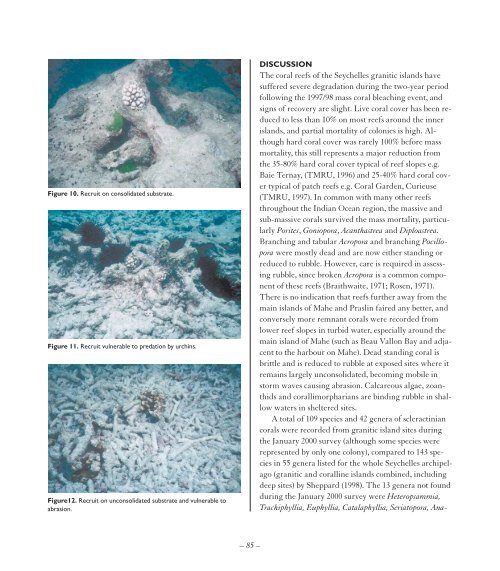Create successful ePaper yourself
Turn your PDF publications into a flip-book with our unique Google optimized e-Paper software.
Figure 10. Recruit on consolidated substrate.<br />
Figure 11. Recruit vulnerable to predation by urchins.<br />
Figure12. Recruit on unconsolidated substrate and vulnerable to<br />
abrasion.<br />
DISCUSSION<br />
The coral reefs of the Seychelles granitic islands have<br />
suffered severe degradation during the two-year period<br />
following the 1997/98 mass coral bleaching event, and<br />
signs of recovery are slight. Live coral cover has been reduced<br />
to less than 10% on most reefs around the inner<br />
islands, and partial mortality of colonies is high. Although<br />
hard coral cover was rarely 100% before mass<br />
mortality, this still represents a major reduction from<br />
the 35-80% hard coral cover typical of reef slopes e.g.<br />
Baie Ternay, (TMRU, 1996) and 25-40% hard coral cover<br />
typical of patch reefs e.g. Coral Garden, Curieuse<br />
(TMRU, 1997). In common with many other reefs<br />
throughout the Indian Ocean region, the massive and<br />
sub-massive corals survived the mass mortality, particularly<br />
Porites, Goniopora, Acanthastrea and Diploastrea.<br />
Branching and tabular Acropora and branching Pocillopora<br />
were mostly dead and are now either standing or<br />
reduced to rubble. However, care is required in assessing<br />
rubble, since broken Acropora is a common component<br />
of these reefs (Braithwaite, 1971; Rosen, 1971).<br />
There is no indication that reefs further away from the<br />
main islands of Mahe and Praslin faired any better, and<br />
conversely more remnant corals were recorded from<br />
lower reef slopes in turbid water, especially around the<br />
main island of Mahe (such as Beau Vallon Bay and adjacent<br />
to the harbour on Mahe). Dead standing coral is<br />
brittle and is reduced to rubble at exposed sites where it<br />
remains largely unconsolidated, becoming mobile in<br />
storm waves causing abrasion. Calcareous algae, zoanthids<br />
and corallimorpharians are binding rubble in shallow<br />
waters in sheltered sites.<br />
A total of 109 species and 42 genera of scleractinian<br />
corals were recorded from granitic island sites during<br />
the January <strong>2000</strong> survey (although some species were<br />
represented by only one colony), compared to 143 species<br />
in 55 genera listed for the whole Seychelles archipelago<br />
(granitic and coralline islands combined, including<br />
deep sites) by Sheppard (1998). The 13 genera not found<br />
during the January <strong>2000</strong> survey were Heteropsammia,<br />
Trachiphyllia, Euphyllia, Catalaphyllia, Seriatopora, Ana-<br />
– 85 –


















